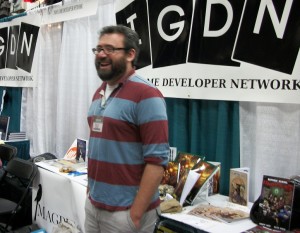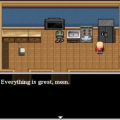What makes a creator of media independent? It’s a question we ask ourselves every day at The Indie Mine, and exploring the answers led us to a meeting with the members of the Indie Game Developer Network (IGDN) at Gen Con 2013 in Indianapolis, Indiana.
Gen Con started in 1968 as a small gathering of tabletop gamers. Like Dragon*Con in Atlanta, and the comic book conventions of San Diego and New York, Gen Con eventually presented a wide variety of media, including general fantasy and science fiction as well as television and video games. But primarily, the convention is associated with non-electronic wargaming and role-playing games, since the show was started by the late Gary Gygax, one of the creators of Dungeons and Dragons. It’s estimated that over 40,000 people visited Gen Con 2013.

Thousands of players gathered in Indianapolis, Indiana for Gen Con 2013 the weekend of August 17. This room is one of fifteen exhibition halls filled with tables for face-to-face gaming.
You can guess right away the question that we would raise at a show like Gen Con. Authors have always been independent, with an identity quite separate from their publishers. Likewise, every musician is considered independent until signed by a label. And with video games in particular, software development kits (SDKs) and Internet distribution make it possible for a solo programmer to reach a wide audience of gamers. How can this also be true of non-electronic games? Can a solo designer or a small team make a board game, or a card game, or an RPG that’s worthwhile?

Mark Diaz Truman, of Magpie Games and the Indie Game Developer Network, answers questions and represents game products at the IGDN booth at Gen Con 2013 in Indianapolis, Indiana.
Mark Diaz Truman, of Albuquerque, New Mexico, thinks that the answer is a resounding yes. Truman and his merry band of independent game designers stood shoulder-to-shoulder with big, established game publishers at Gen Con. From their booth, the IGDN offered product demonstrations and sales in the same environment as Wizards of the Coast, Chaosium and Steve Jackson Games.
The IGDN was created by Truman, 31, and a number of like-minded designers who couldn’t bear reinventing the wheel over and over again. While it’s possible to do business outside of mainstream channels, these designers found it difficult to communicate productively, even with technology to connect people. In an effort to pool their knowledge and experience, they created a private e-mail distribution list to have honest exchanges away from the noise of the general Internet. Eventually the IGDN became more like a traditional trade and labor organization, with yearly dues and bylaws.
Truman’s organization is sensitive to the challenges that face independent game designers, which are also common to all indie media creators. “It’s hard to get people to try a new game,” said Truman. “Freelance and indie game design has never paid much, and folks have to work a long time to build a reputation. It’s easy to get in over your head with a print run that’s too large or a project that runs over budget while falling behind.”
In that light, the purpose of the IGDN is not just to share information, but to pool resources as well. Truman said their industry booth “was made possible by the joint efforts of our membership. Alone we would only be able to purchase small advertisements, but together we can actually put our books out in front of fans at Gen Con in a really exciting way.”
When pressed to explain how an indie game designer is different from a mainstream game company employee, Truman cited the example of his own recent work on a major RPG based on a television property. In Truman’s eyes, there is no conflict in accepting freelance or contract work from major companies while still producing your own material. “My independent impulse will always allow that I work on the projects that I am excited about,” said Truman. “The gaming industry doesn’t work like it used to. There’s no such thing as selling out in this business.”
Truman went on to describe the conflict between commerce and art that exists in independent games, and for all independent media. “It’s really a spectrum, not a chasm,” he said of the division between the two. “If a game is good on its own, then people will buy it. But some creators care less about sales than they do about making a point. An independent game creator has passion.”
So what is Mark Diaz Truman passionate about? As a graduate of the Harvard-Kennedy School of Government, with a Master’s degree in public policy, Truman cares a great deal about social inequality as it relates to issues of race and gender. This passion is reflected in his ambitious flagship game, the short-form RPG “Our Last Best Hope”. Truman said that he wanted to improve on the tropes of the disaster movie by making a game where many nations had to gather a diverse group of experts to avert some world-ending crisis.
“I think the most exciting part of the indie movement is the innovation, both in terms of setting and mechanics,” said Truman. He pointed out several tabletop games which addressed controversial or uncomfortable subjects meant to challenge players, and which wouldn’t necessarily be sold by any mainstream game company. Among them were Kagematsu, an RPG that encourages male gamers to think about medieval gender disparity, and Fiasco, about amateur crimes gone horribly wrong.
Have we answered the question of what makes a media creator independent? Truman thinks it’s a question we’ll continue to debate for a while. “It’s really hard to define what makes someone ‘indie’ and it’s a topic that a lot of smarter folks than me have fought over for years before I even got into publishing,” he said. “For the IGDN, we really focus on looking for members who are maintaining as much creative ownership and control as possible. We care a lot less about where you work or if this is your full time job than we do if you are acting as a creative agent. ”
© 2013, The Indie Mine. All rights reserved.




Trackbacks/Pingbacks
[…] The Indie Mine : The Indie Game Developer Network at Gen Con 2013 […]